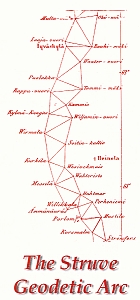The Struve Geodetic Arc approved to the World Heritage List
15 July, Durban, South Africa
The World Heritage Committee, chaired by Themba Wakashe, South
Africa’s Deputy Director-General for Heritage and National Archives,
inscribed 17 cultural sites on UNESCO’s World Heritage List 15 July at its
meeting in Durban South Africa.
The World Heritage List now numbers 812 sites in total, which includes:
628 cultural; 160 natural and 24 mixed sites in 137 States Parties. With
today’s inscriptions. Bahrain, the Republic of Moldova and Bosnia and
Herzegovina enter the List for the first time. The sites inscribed during
the current session of the World Heritage Committee include three
transboundary sites and extensions to six sites that were already on the
List.
 |
Struve Arc as the first surveying
site on the list - Belarus, Estonia, Finland, Latvia, Lithuania, Norway,
Republic of Moldova, Russian Federation, Sweden, Ukraine host the Struve
Geodetic Arc The Struve Arc
is a chain of survey triangulations stretching from Hammerfest in Norway
to the Black Sea, through ten countries and over 2,820km. These are
points of a survey, carried out between 1816 and 1855 by the astronomer
Friedrich Georg Wilhelm Struve, which represented the first
accurate measuring of a long segment of a meridian. This helped
establish the exact size and shape of our planet and marked an important
step in the development of earth sciences and topographic mapping. It is
an extraordinary example of scientific collaboration among scientists
from different countries, and of collaboration between monarchs for a
scientific cause. The original arc consisted of 258 main triangles with
265 main station points. The listed site includes 34 of the original
station points, with different markings, i.e. a drilled hole in rock,
iron cross, cairns, or built obelisks. |
Further information:
UNESCO, 15 July 2005 |

